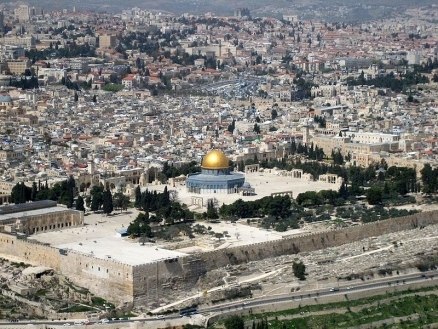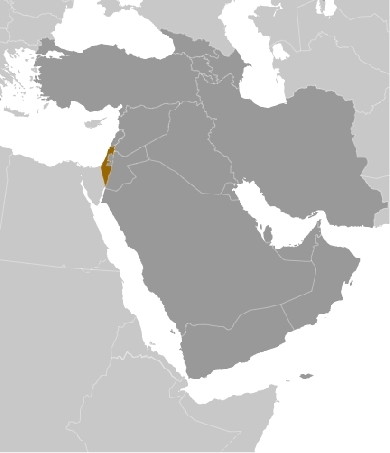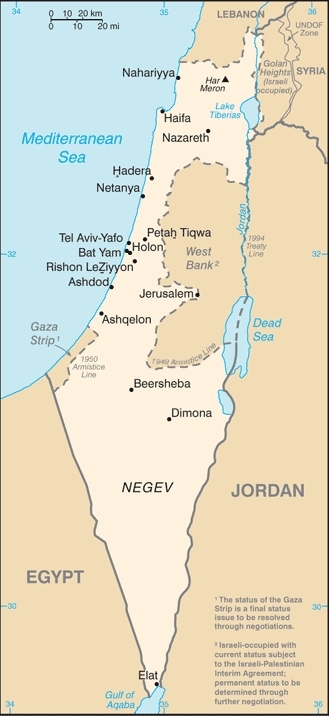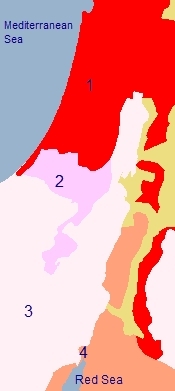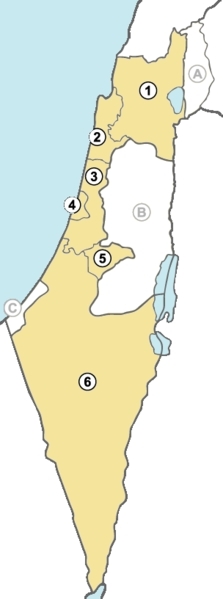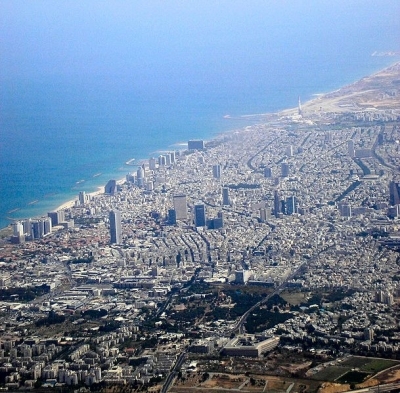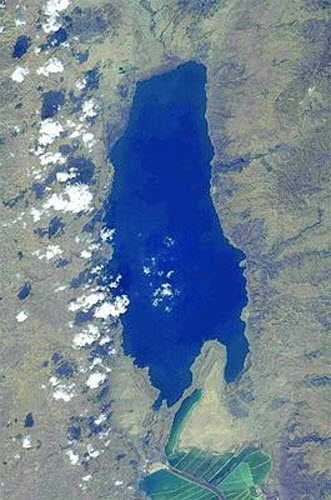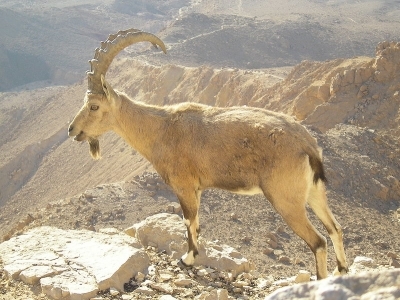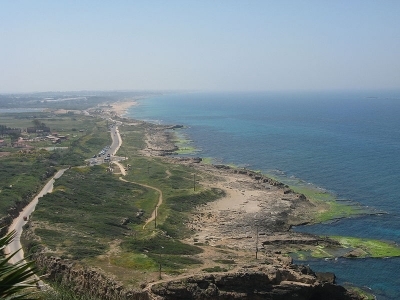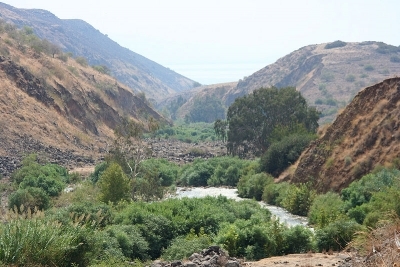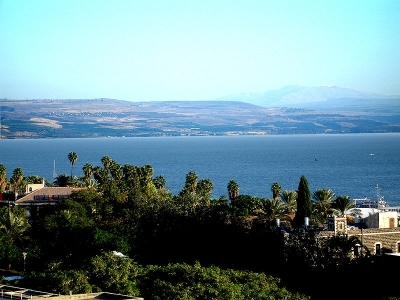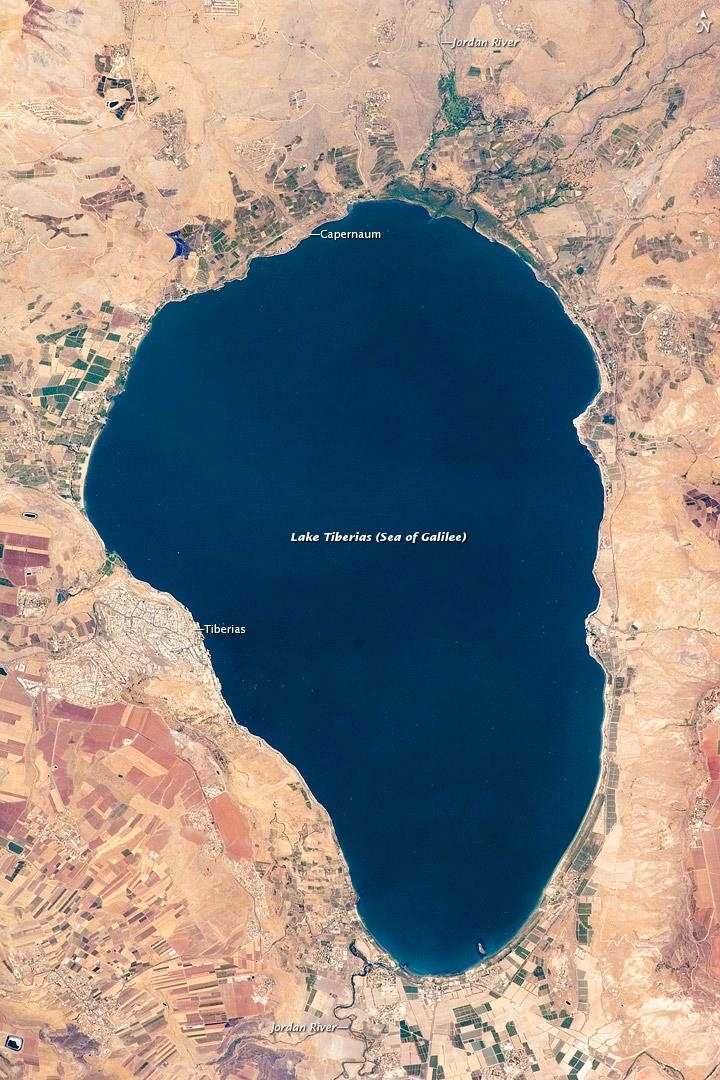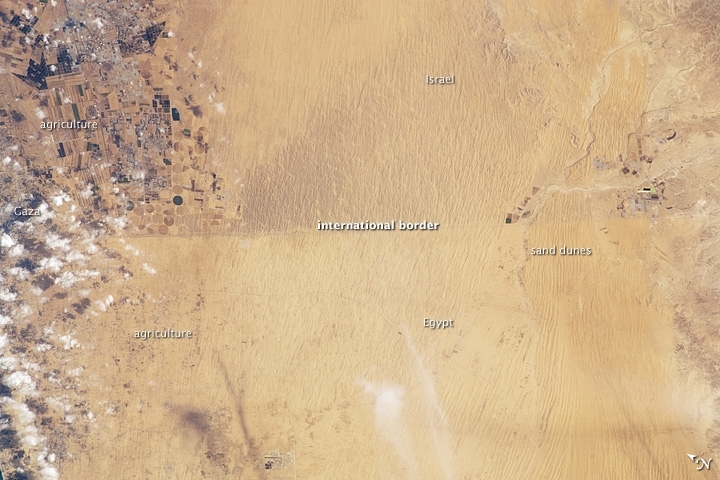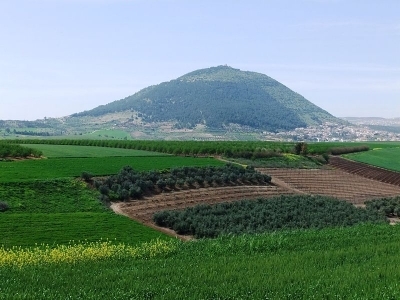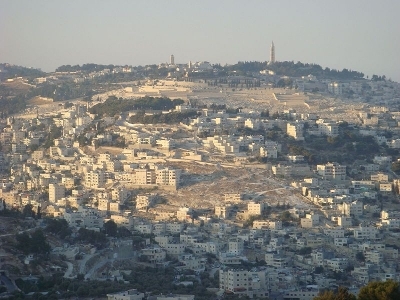Israel
Countries and Regions of the World Collection  Israel is a nation of about seven-and-a-half million people in the Middle East, bordering the Mediterranean Sea, between Egypt and Lebanon.
Israel is a nation of about seven-and-a-half million people in the Middle East, bordering the Mediterranean Sea, between Egypt and Lebanon.
The lands of the nation of Israel are the homeland of the ancient Jewish people, and manifest a rich cultural and archaeological heritage as the locus of many important events not only in the history of Judaism, but also for Christianity and Islam.
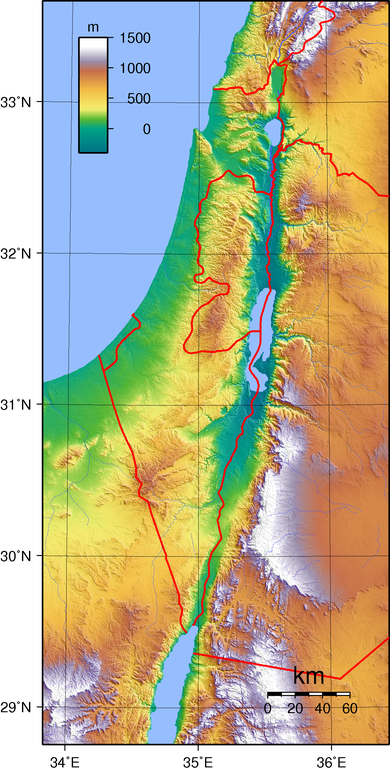 Topography of Israel. Source: Wikipedia Topography of Israel. Source: Wikipedia
|
Its major environmental issues include:
- Limited arable land and natural freshwaterresources pose serious constraints;
- Desertification;
- Air pollution from industrial and vehicle emissions;
- Groundwater pollution from industrial and domestic waste, chemical fertilizers, pesticides and herbicides.
Israel is susceptible to sandstorms may occur during spring and summer; droughts; and periodic earthquakes.
Lake Tiberias (Sea of Galilee) is an important freshwater source. The Dead Sea is a historically significant hypersaline lake, forming part of the border with Jordan.
Following World War II, the British withdrew from their mandate of Palestine, and the UN partitioned the area into Arab and Jewish states, an arrangement rejected by the Arabs.
Subsequently, the Israelis defeated the Arabs in a series of wars without ending the deep tensions between the two sides.
The territories Israel occupied since the 1967 war are not included in this Israel country profile, unless otherwise noted.
On 25 April 1982, Israel withdrew from the Sinai pursuant to the 1979 Israel-Egypt Peace Treaty.
In keeping with the framework established at the Madrid Conference in October 1991, bilateral negotiations were conducted between Israel and Palestinian representatives and Syria to achieve a permanent settlement. Israel and Palestinian officials signed on 13 September 1993 a Declaration of Principles (also known as the "Oslo Accords") guiding an interim period of Palestinian self-rule.
Outstanding territorial and other disputes with Jordan were resolved in the 26 October 1994 Israel-Jordan Treaty of Peace. In addition, on 25 May 2000, Israel withdrew unilaterally from southern Lebanon, which it had occupied since 1982.
In April 2003, US President Bush, working in conjunction with the EU, UN, and Russia - the "Quartet" - took the lead in laying out a roadmap to a final settlement of the conflict by 2005, based on reciprocal steps by the two parties leading to two states, Israel and a democratic Palestine. However, progress toward a permanent status agreement was undermined by Israeli-Palestinian violence between September 2003 and February 2005.
In the summer of 2005, Israel unilaterally disengaged from the Gaza Strip, evacuating settlers and its military while retaining control over most points of entry into the Gaza Strip.
The election of Hamas to head the Palestinian Legislative Council froze relations between Israel and the Palestinian Authority (PA).
Ehud Olmert became prime minister in March 2006 and presided over a 34-day conflict with Hizballah in Lebanon in June-August 2006 and a 23-day conflict with Hamas in the Gaza Strip during December 2008 and January 2009. Olmert, who in June 2007 resumed talks with PA President Mahmoud Abbas, resigned in September 2008.
Prime Minister Binyamin Netanyahu formed a coalition in March 2009 following a February 2009 general election.
Direct talks launched in September 2010 collapsed following the expiration of Israel's 10-month partial settlement construction moratorium in the West Bank.
Contents
Geography
Location: Middle East, bordering the Levantine Sea, which is the easternmost element of the Mediterranean Sea, between Egypt and Lebanon
Geographic Coordinates: 31 30 N, 34 45 E
Area: 20,770 square kilometers (sq km) , comprised of: land: 20,330 sq km; water: 440 sq km
Land Boundaries: 1017 km (Egypt 266 km, Gaza Strip 51 km, Jordan 238 km, Lebanon 79 km, Syria 76 km, West Bank 307 km)
Coastline: 273 km
Maritime Claims:
- Territorial sea: 12 nm
- Continental shelf: to depth of exploitation
Natural Hazards: Sandstorms may occur during spring and summer; droughts; periodic earthquakes
Terrain: Negev Desert in the south; low coastal plain; central mountains; Jordan Rift Valley. The highest topographic point is Har Meron (1208 meters) and the lowest point the Dead Sea (-408 meters), which is also Earth's lowest surface location.
Climate: Temperate; hot and dry in southern and eastern desert areas
Ecology and Biodiversity
|
The country of Israel consists of three principal ecoregions:
Map Source: World Wildlife Fund The Eastern Mediterranean conifer-schlerophyllous-broadleaf forests are particulary notable, because they support a key migratory bird route, which brings vast numbers of birds south from Eurasasia to Africa each winter; many of these migratory birds are globally threatened species. For further regional information on biodiversity, one can consult: Biological diversity in the Mediterranean Basin. |
Government
|
Israel is a parliamentary democracy. Its governmental system is based on several basic laws enacted by its unicameral parliament, the Knesset. The president (head of state) is elected by the Knesset for a 5-year term. The Knesset's 120 members are elected by secret ballot to 4-year terms, although the prime minister may decide to call for new elections before the end of the 4-year term. Voting is for party lists rather than for individual candidates, and the total number of seats assigned each party reflects that party's percentage of the vote. Successful Knesset candidates are drawn from the lists in order of party-assigned rank. Under the present electoral system, all members of the Knesset are elected at large. | |
|
Government Type: Parliamentary democracy Capital: Jerusalem (population: 768,000; 2009) - Israel proclaimed Jerusalem as its capital in 1950, but the US, like all other countries, maintains its Embassy in Tel Aviv Other major cities: Tel Aviv-Yafo (population: 3.219 million; 2009); Haifa (population: 1.027 million; 2009) Adminstrative Divisions: Israel is divided into six districts (mehozot, singular - mehoz), administration of which is coordinated by the Ministry of Interior. The Ministry of Defense is responsible for the administration of the occupied territories;
Other areas noted on the map right:
Map source: Wikimedia Commons Independence Date: 14 May 1948 (from League of Nations mandate under British administration) Legal System: Mixed legal system of English common law, British Mandate regulations, and Jewish, Christian, and Muslim religious laws. Israel has not submitted an International court of Justice (ICJ) jurisdiction declaration and withdrew acceptance of International Criminal Court (ICCt) jurisdiction in 2002 The independent judicial system includes secular and religious courts. The courts' right of judicial review of the Knesset's legislation is limited. Judicial interpretation is restricted to problems of execution of laws and validity of subsidiary legislation. The highest court in Israel is the Supreme Court, whose judges are approved by the President. |
|
International Environmental Agreements
Israel is party to to international agreements on: Biodiversity, Climate Change, Climate Change-Kyoto Protocol, Desertification, Endangered Species, Hazardous Wastes, Ozone Layer Protection, Ship Pollution, Wetlands, and Whaling. It has signed, but not ratified and agreement on Marine Life Conservation.
| Tel Aviv-Yaffo. Source: Deror avi/Wikimedia Commons |
| Dead Sea viewed from space; Israel at image bottom; Jordan at image top. Source: NASA |
| Nubian ibex (Vulnerable) in the Negev Desert mountains. |
| Mediterranean coast viewed from Rosh Hanikra mount in northern Israel. |
| An antique menorah, used in celebration of the Jewish holiday, Hanukkah. |
| The Jordan River. Source: Wikimedia Commons |
| The view from Tiberias, Galilee, Israel, northward across the Sea of Galilee. The snowy peak in the distance is Mount Hermon. Source: Joe Freeman |
People and Society
Of the approximately 7.59 million Israelis in 2010, about 76% were counted as Jewish, though some of those are not considered Jewish under Orthodox Jewish law. Since 1989, nearly a million immigrants from the former Soviet Union have arrived in Israel, making this the largest wave of immigration since independence. In addition, an estimated 105,000 members of the Ethiopian Jewish community have immigrated to Israel, 14,000 of them during the dramatic May 1991 Operation Solomon airlift; 32.9% of Israelis were born outside of Israel.
The three broad Jewish groupings are the Ashkenazim, or Jews who trace their ancestry to western, central, and eastern Europe; the Sephardim, who trace their origin to Spain, Portugal, southern Europe, and North Africa; and Eastern or Oriental Jews, who descend from ancient communities in Islamic lands. Of the non-Jewish population, about 68% are Muslims, about 9% are Christian, and about 7% are Druze.
Education is compulsory from age 6 to 16 and is free up to age 18. The school system is organized into kindergartens, 6-year primary schools, 3-year junior secondary schools, and 3-year senior secondary schools, after which a comprehensive examination is offered for university admissions. There are seven university-level institutions in Israel, a number of regional colleges, and an Open University program.
With a population drawn from more than 100 countries on 5 continents, Israeli society is rich in cultural diversity and artistic creativity. The arts are actively encouraged and supported by the government. The Israeli Philharmonic Orchestra performs throughout the country and frequently tours abroad. The Jerusalem Symphony and the New Israel Opera also tour frequently, as do other musical ensembles. Almost every municipality has a chamber orchestra or ensemble, many boasting the talents of gifted performers from the countries of the former Soviet Union.
Israel has several professional ballet and modern dance companies, and folk dancing, which draws upon the cultural heritage of many immigrant groups, continues to be very popular. There is great public interest in the theater; the repertoire covers the entire range of classical and contemporary drama in translation as well as plays by Israeli authors. Of the three major repertory companies, the most famous, Habimah, was founded in 1917.
Active artist colonies thrive in Safed, Jaffa, and Ein Hod, and Israeli painters and sculptors exhibit works worldwide. Israel boasts more than 120 museums, including the Israel Museum in Jerusalem, which houses the Dead Sea Scrolls along with an extensive collection of regional archaeological artifacts, art, and Jewish religious and folk exhibits. Israelis are avid newspaper readers, with more than 90% of Israeli adults reading a newspaper at least once a week. Major daily papers are in Hebrew; others are in Arabic, English, French, Polish, Yiddish, Russian, Hungarian, and German.
Population: 7,590,758 (July 2012 est.)
Approximately 311,100 Israeli settlers live in the West Bank (2010); approximately 18,100 Israeli settlers live in the Golan Heights (2010); approximately 186,929 Israeli settlers live in East Jerusalem (2010)
Ethnic groups: Jewish 76.4% (of which Israel-born 67.1%, Europe/America-born 22.6%, Africa-born 5.9%, Asia-born 4.2%), non-Jewish 23.6% (mostly Arab) (2004)
Age Structure:
0-14 years: 27.6% (male 1,057,113/female 1,008,978)
15-64 years: 62.2% (male 2,358,858/female
2,292,281)
65 years and over: 10.1% (male 331,034/female 424,788) (2011 est.)
Population Growth Rate: 1.541% (2012 est.)
Birthrate: 18.97 births/1,000 population (2012 est.)
Death Rate: 5.5 deaths/1,000 population (July 2012 est.)
Net Migration Rate: 1.94 migrant(s)/1,000 population (2012 est.)
Life Expectancy at Birth: 81.07 years (2012 est.)
Total Fertility Rate: 2.67 children born/woman (2012 est.)
Languages: Hebrew (official), Arabic (used officially for Arab minority), English (most commonly used foreign language)
Literacy: (Age 15 and over can read and write): 97.1% (2004 est.)
Urbanization: 92% of total population (2010) growing at anannual rate of change of 1,5 % (2010-15 est.)
History
The creation of the State of Israel in 1948 was preceded by more than 50 years of efforts to establish a sovereign state as a homeland for Jews. These efforts were initiated by Theodore Herzl, founder of the Zionist movement, and were given added impetus by the Balfour Declaration of 1917, which asserted the British Government's support for the creation of a Jewish homeland in Palestine.
In the years following World War I, Palestine became a British Mandate and Jewish immigration steadily increased, as did violence between Palestine's Jewish and Arab communities. Mounting British efforts to restrict this immigration were countered by international support for Jewish national aspirations following the near-extermination of European Jewry by the Nazis during World War II. This support led to the 1947 UN partition plan, which would have divided Palestine into separate Jewish and Arab states, with Jerusalem under UN administration.
On May 14, 1948, soon after the British quit Palestine, the State of Israel was proclaimed and was immediately invaded by armies from neighboring Arab states, which rejected the UN partition plan. This conflict, Israel's War of Independence, was concluded by armistice agreements between Israel, Egypt, Jordan, Lebanon, and Syria in 1949 and resulted in a 50% increase in Israeli territory.
In 1956, French, British, and Israeli forces engaged Egypt in response to its nationalization of the Suez Canal and blockade of the Straits of Tiran. Israeli forces withdrew in March 1957, after the United Nations established the UN Emergency Force (UNEF) in the Gaza Strip and Sinai. This war resulted in no territorial shifts and was followed by several years of terrorist incidents and retaliatory acts across Israel's borders.
In June 1967, Israeli forces struck targets in Egypt, Jordan, and Syria in response to Egyptian President Nasser's ordered withdrawal of UN peacekeepers from the Sinai Peninsula and the buildup of Arab armies along Israel's borders. After 6 days, all parties agreed to a cease-fire, under which Israel retained control of the Sinai Peninsula, the Golan Heights, the Gaza Strip, the formerly Jordanian-controlled West Bank of the Jordan River, and East Jerusalem. On November 22, 1967, the Security Council adopted Resolution 242, the "land for peace" formula, which called for the establishment of a just and lasting peace based on Israeli withdrawal from territories occupied in 1967 in return for the end of all states of belligerency, respect for the sovereignty of all states in the area, and the right to live in peace within secure, recognized boundaries.
The following years were marked by continuing violence across the Suez Canal, punctuated by the 1969-70 war of attrition. On October 6, 1973--Yom Kippur (the Jewish Day of Atonement), the armies of Syria and Egypt launched an attack against Israel. Although the Egyptians and Syrians initially made significant advances, Israel was able to push the invading armies back beyond the 1967 cease-fire lines by the time the United States and the Soviet Union helped bring an end to the fighting. In the UN Security Council, the United States supported Resolution 338, which reaffirmed Resolution 242 as the framework for peace and called for peace negotiations between the parties.
In the years that followed, sporadic clashes continued along the cease-fire lines, but guided by the U.S., Egypt and Israel continued negotiations. In November 1977, Egyptian President Anwar Sadat made a historic visit to Jerusalem, which opened the door for the 1978 Israeli-Egyptian peace summit convened at Camp David by President Jimmy Carter. These negotiations led to a 1979 peace treaty between Israel and Egypt, signed by President Sadat of Egypt and Prime Minister Menachem Begin of Israel, after which Israel withdrew from the Sinai in 1982.
In the years following the 1948 war, Israel's border with Lebanon was quiet relative to its borders with other neighbors. After the expulsion of Palestinian fighters from Jordan in 1970 and their influx into southern Lebanon, however, hostilities along Israel's northern border increased and Israeli forces crossed into Lebanon in 1978. After passage of Security Council Resolution 425, calling for Israeli withdrawal and the creation of the UN Interim Force in Lebanon peacekeeping force (UNIFIL), Israel withdrew its troops.
In June 1982, following a series of cross-border terrorist attacks and the attempted assassination of the Israeli Ambassador to the U.K., Israel invaded Lebanon to fight the forces of Yasser Arafat's Palestine Liberation Organization (PLO). The PLO withdrew its forces from Lebanon in August 1982. Israel, having failed to finalize an agreement with Lebanon, withdrew most of its troops in June 1985 save for a residual force which remained in southern Lebanon to act as a buffer against attacks on northern Israel. These remaining forces were completely withdrawn in May 2000 behind a UN-brokered delineation of the Israel-Lebanon border (the Blue Line). Hezbollah forces in Southern Lebanon continued to attack Israeli positions south of the Blue Line in the Shaaba Farms/Har Dov area of the Golan Heights.
The victory of the U.S.-led coalition in the Persian Gulf War of 1991 opened new possibilities for regional peace. In October 1991, the United States and the Soviet Union convened the Madrid Conference, in which Israeli, Lebanese, Jordanian, Syrian, and Palestinian leaders laid the foundations for ongoing negotiations designed to bring peace and economic development to the region. Within this framework, Israel and the PLO signed a Declaration of Principles on September 13, 1993, which established an ambitious set of objectives relating to a transfer of authority from Israel to an interim Palestinian authority. Israel and the PLO subsequently signed the Gaza-Jericho Agreement on May 4, 1994, and the Agreement on Preparatory Transfer of Powers and Responsibilities on August 29, 1994, which began the process of transferring authority from Israel to the Palestinians.
On October 26, 1994, Israel and Jordan signed a historic peace treaty, witnessed by President Bill Clinton. This was followed by Israeli Prime Minister Rabin and PLO Chairman Arafat's signing of the historic Israeli-Palestinian Interim Agreement on September 28, 1995. This accord, which incorporated and superseded previous agreements, broadened Palestinian self-government and provided for cooperation between Israel and the Palestinians in several areas.
Israeli Prime Minister Yitzhak Rabin was assassinated on November 4, 1995, by a right-wing Jewish radical, bringing the increasingly bitter national debate over the peace process to a climax. Subsequent Israeli governments continued to negotiate with the PLO resulting in additional agreements, including the Wye River and the Sharm el-Sheikh memoranda. However, a summit hosted by President Clinton at Camp David in July 2000 to address permanent status issues--including the status of Jerusalem, Palestinian refugees, Israeli settlements in the West Bank and Gaza, final security arrangements, borders, and relations and cooperation with neighboring states--failed to produce an agreement.
Following the failed talks, widespread violence broke out in Israel, the West Bank, and Gaza in September 2000. In April 2001 the Sharm el-Sheikh Fact Finding Committee, commissioned by the October 2000 Middle East Peace Summit and chaired by former U.S. Senator George Mitchell, submitted its report, which recommended an immediate end to the violence followed by confidence-building measures and a resumption of security cooperation and peace negotiations. Building on the Mitchell report, in April 2003, the Quartet (the U.S., UN, European Union (EU), and the Russian Federation) announced the "roadmap," a performance-based plan to bring about two states, Israel and a democratic, viable Palestine, living side by side in peace and security.
Despite the promising developments of spring 2003, violence continued and in September 2003 the first Palestinian Prime Minister, Mahmoud Abbas (Abu Mazen), resigned after failing to win true authority to restore law and order, fight terror, and reform Palestinian institutions. In response to the deadlock, in the winter of 2003-2004 Prime Minister Sharon put forward his Gaza disengagement initiative, proposing the withdrawal of Israeli settlements from Gaza as well as parts of the northern West Bank. President George W. Bush endorsed this initiative in an exchange of letters with Prime Minister Sharon on April 14, 2004, viewing Gaza disengagement as an opportunity to move towards implementation of the two-state vision and begin the development of Palestinian institutions. In a meeting in May 2004 the Quartet endorsed the initiative, which was approved by the Knesset in October 2004.
The run-up to disengagement saw a flurry of diplomatic activity, including the February 2005 announcement of Lieutenant General William Ward and subsequently Lieutenant General Keith Dayton as U.S. Security Coordinator; the March 2005 Sharon-Abbas summit in Sharm el-Sheikh; the return of Egyptian and Jordanian ambassadors to Israel; and the May 2005 appointment of former World Bank president James D. Wolfensohn as Special Envoy for Gaza Disengagement to work for a revitalization of the Palestinian economy after disengagement.
On August 15, 2005, Israel began implementing its disengagement from the Gaza Strip, and the Israeli Defense Forces completed their withdrawal, including the dismantling of 17 settlements, on September 12. After broad recognition for Prime Minister Sharon's accomplishment at that fall's UN General Assembly, international attention quickly turned to efforts to strengthen Palestinian governance and the economy in Gaza. The United States brokered a landmark Agreement on Movement and Access between the parties in November 2005 to facilitate further progress on Palestinian economic issues. However, the terrorist organization Hamas--building on popular support for its "resistance" to Israeli occupation and a commitment to clean up the notorious corruption of the Palestinian Authority (PA)--took a majority in the January 2006 Palestinian Legislative Council (PLC) elections, with Hamas leader Ismail Haniya as Prime Minister. The Israeli leadership pledged not to work with a Palestinian government in which Hamas had a role.
Shortly following Hamas' PLC victory, the Quartet--comprised of the United States, European Union, United Nations, and Russia--outlined three basic principles the Hamas-led PA must meet in order for the U.S. and the international community to reengage with the PA: renounce violence and terror, recognize Israel, and respect previous agreements, including the roadmap. The Hamas-led PA government rejected these principles, resulting in a Quartet statement of "grave concern" on March 30, 2006 and the suspension of U.S. assistance to the PA, complete prohibition on U.S. Government contacts with the PA, and prohibition of unlicensed transactions with the PA government. The Palestine Liberation Organization (PLO) under the leadership of PLO Chairman and PA President Mahmud Abbas (Abu Mazen), by contrast, remained consistently committed to the Quartet principles.
Despite several negotiated cease-fires between Hamas and Fatah, violent clashes in the Gaza Strip--and to a lesser extent in the West Bank--were commonplace between December 2006 and February 2007 and resulted in dozens of deaths and injuries. In an attempt to end the intra-Palestinian violence, the King of Saudi Arabia invited Palestinian rivals to Mecca, and on February 9, 2007, Abbas and Hamas leader Haniya agreed to the formation of a Palestinian national unity government and a cessation of violence. Hamas' rejectionist policies and violent behavior continued despite the formation of the national unity government.
In June 2007, Hamas effectively orchestrated a violent coup in Gaza. Hamas also launched scores of Qassam rockets into southern Israel in an attempt to involve Israel in the Hamas-Fatah conflict. On June 14, Palestinian Authority President Mahmoud Abbas exercised his lawful authority by declaring a state of emergency, dissolving the national unity government, and replacing it with a new government with Salam Fayyad as Prime Minister.
The Palestinian Authority (PA) government under President Abbas and Prime Minister Fayyad has no elements controlled by Hamas. The government is dedicated to pursuing a negotiated solution to the Arab-Israeli conflict, and the Quartet principles. As a result, the PA has been supported politically and financially by the international community, and engaged by Israel. The U.S. reinstated its assistance to the PA in 2007 and provides budget and development assistance as well as support for the PA’s efforts to reform and improve security and rule of law in the West Bank.
In November 2007, Israeli and Palestinian leaders participated in an international conference in Annapolis, at which they committed to launch bilateral negotiations towards the establishment of a Palestinian state in the West Bank and Gaza, and the realization of Israeli-Palestinian peace. During the year that followed, Israeli Prime Minister Olmert and Palestinian Authority President Abbas and other members of their governments engaged in regular bilateral negotiations on final status issues. Although the two sides reportedly narrowed their differences on some issues, the negotiations were suspended in December 2008 when conflict broke out between Israel and Hamas in Gaza.
On December 27, 2008, in response to a sharp increase in the number and frequency of rocket attacks into Israel shortly prior to and following the formal expiration of a 6-month "calm" between Israel and Hamas, the Israel Defense Forces launched Operation Cast Lead, targeting Hamas security installations, personnel, and other facilities in the Gaza Strip. The Israeli military operation continued until January 18, 2009, when Israel and Hamas each declared a unilateral cease-fire.
On January 22, 2009, President Barack Obama named Senator Mitchell his and Secretary of State Hillary Clinton’s special envoy for Middle East peace. Special Envoy Mitchell immediately traveled to the region and subsequently returned on a nearly monthly basis in an effort to help create the conditions that would support a two-state solution and to re-launch credible and productive negotiations. The President has visited Turkey, Egypt, and Saudi Arabia and hosted Prime Minister Netanyahu and numerous Arab heads of state in Washington, DC. On September 22, 2009 he hosted a trilateral meeting with Prime Minister Netanyahu and President Abbas, and he has written to over a dozen Arab heads of state asking for their assistance in ending the Arab-Israeli conflict. Senator Mitchell began indirect talks between the two parties in March 2010, and direct talks were launched on September 2, 2010 in Washington, DC. Secretary Clinton has met many leaders from the region and has traveled to the Middle East multiple times since her appointment to promote a Middle East peace settlement.
Water
Total Renewable Water Resources: 1.7 cu km (2001)
Freshwater Withdrawal: 2.05 cu km/yr (31% domestic, 7% industrial, 62% agricultural)
Per Capita Freshwater Withdrawal: 305 cu m/yr (2000)
Israel's largest freshwater lake, Lake Tiberias, is also known as the Sea of Galilee. The lake measures just over 21 km (13 mi) north-south, and it is only 43 m (141 ft) deep. The lake is fed partly by underground springs related to the Jordan sector of the Great Rift Valley, but most of its water comes from the Jordan River, which enters from the north. The river's winding course can be seen draining the south end of the lake at image bottom. Angular green and brown field patterns clothe most hillsides in this arid landscape. Bright roof tops are the hallmark of several villages in the area. Much of the area to the east of the lake is part of the Israeli-occupied Golan Heights. Image courtesy of NASA.
Agriculture
Agricultural products: Citrus, vegetables, cotton; beef, poultry, dairy products
Irrigated Land: 2250 sq km (2008)
A clearly visible line marks about 50 kilometers of the international border between Egypt and Israel in this astronaut photograph. The area shown lies between 10 to 60 kilometers (from left to right) from the Mediterranean Sea, which is beyond this image to the northwest. This image from the International Space Station shows the characteristic sand dune morphology of the region and the poor soils which mark the southern limit of agriculture.
The different colors of the land surface are the result of trampling by humans and their livestock. Trampling disturbs the dark-colored soil crusts on the Egyptian side of the border, allowing lighter-colored dune sand beneath the crusts to be exposed by winds. A road also follows the border, making the demarcation more prominent. A patch of the Gaza Strip appears under scattered clouds at extreme image left.
In the arid to semiarid climate of the region, the natural vegetation is mostly sparse shrubs. Irrigated commercial agriculture in Israel appears as a series of large angular patterns and circular center pivot fields, with darker greens indicating growing crops (image left). Smaller plots appear on the Egyptian side of the border at image lower left. Source: NASA.Credit: Astronaut photograph ISS029-E-37471 was acquired on November 3, 2011
Resources
Natural Resources: Timber, potash, copper ore, natural gas, phosphate rock, Magnesium bromide, clays, sand
Land Use:
- Arable land: 15.45%
- Permanent crops: 3.88%
- Other: 80.67% (2005)
Economy
Israel has a diversified, technologically advanced economy with substantial but decreasing government ownership and a strong high-tech sector. The major industrial sectors include high-technology electronic and biomedical equipment, metal products, processed foods, chemicals, and transport equipment. Israel possesses a substantial service sector and is one of the world's centers for diamond cutting and polishing. It also is a world leader in software development and, prior to the violence that began in September 2000, was a major tourist destination.
| Mount Tabor in northern Israel. |
| Mount of Olives, Jerusalem from Sherover-Hass-Goldman promenade in East Talpiot. Source: David Lisbona |
Israel's strong commitment to economic development and its talented work force led to economic growth rates during the nation's first 2 decades that frequently exceeded 10% annually. The years after the 1973 Yom Kippur War were a lost decade economically, as growth stalled and inflation reached triple-digit levels. The successful economic stabilization plan implemented in 1985 and the subsequent introduction of market-oriented structural reforms reinvigorated the economy and paved the way for rapid growth in the 1990s.
A wave of Jewish immigration beginning in 1989, predominantly from the countries of the former U.S.S.R., brought nearly a million new citizens to Israel. These new immigrants, many of them highly educated, now constitute some 13% of Israel's 7.5 million inhabitants. Their successful absorption into Israeli society and its labor force forms a remarkable chapter in Israeli history. The skills brought by the new immigrants and their added demand as consumers gave the Israeli economy a strong upward push and in the 1990s, they played a key role in the ongoing development of Israel's high-tech sector.
During the 1990s, progress in the Middle East peace process, beginning with the Madrid Conference of 1991, helped to reduce Israel's economic isolation from its neighbors and opened up new markets to Israeli exporters farther afield. The peace process stimulated an unprecedented inflow of foreign investment in Israel, and provided a substantial boost to economic growth in the region over the last decade. The onset of the intifada beginning at the end of September of 2000, the downturn in the high-tech sector and NASDAQ crisis, and the slowdown of the global economy have all significantly affected the Israeli economy. However, despite the conflicts in Gaza and Lebanon, the Israeli economy grew during 2006.
Israeli companies, particularly in the high-tech area, have in the past enjoyed considerable success raising money on Wall Street and other world financial markets; Israel has approximately the same number of companies listed on NASDAQ as the next three countries (Canada, Japan, and Ireland) combined. Israel's tech market is very developed, and in spite of the pause in the industry's growth, the high-tech sector is likely to be the major driver of the Israeli economy. Almost 45% of Israel's exports are high tech. Most leading players, including Intel, Motorola, IBM, and Cisco have a presence in Israel.
After growing by an exceptional 9.2% in 2000, growth was negative in 2001 and 2002, as a result of the security situation, global recession, and high-tech downturn. Growth returned in 2003, and as a result of the improvement in the security situation and the economic recovery plan undertaken by the Government of Israel, the Israeli economy grew by an average of more than 5% per year from 2004 to 2007. This was followed by growth of 4.2% in 2008. With the onset of the global financial crisis, the slowdown in the Israeli economy only began in the third quarter of 2008, but had largely recovered by the third quarter of 2009. Unemployment reached a high of 10.7% in 2003, a level not seen in 20 years, and declined consistently each year until 2008, when it reached 6.1%, the lowest level since 1995. The global economic slowdown raised the 2009 unemployment rate to 7.6%.
Trade of goods and services in Israel grew by 9.3% and 5.2%, respectively, in 2006 and 2007. Exports declined by a sharp 35.6% in the fourth quarter of 2008 and 28.6% in the first quarter of 2009. Diamond exports alone declined by more than 36% in the fourth quarter of 2008 compared with the same quarter the previous year. Agricultural exports, which increased by 44% in 2007, declined by almost 12% in the fourth quarter of 2008. However, recovery was well underway by early 2010, with exports posting 15.8% growth in the second quarter while imports were up 8.3%.
The general consensus among economists is that Israel entered the global economic crisis in relatively good shape. Because the Government of Israel maintained conservative policies during the crisis and avoided ambitious fiscal spending packages, the Israeli economy is expected to quickly emerge from a shallow recession and return to a path of growth, even if not at levels that were seen prior to the crisis.
The United States is Israel's largest single trading partner. In 2009, bilateral trade totaled $22.3 billion, a decline of about 20% over 2008, victim of the slowdown in global trade. The U.S. trade deficit with Israel was $11.1 billion in 2009. The principal goods exported from the U.S. include civilian aircraft parts, telecommunications equipment, semiconductors, civilian aircraft, electrical apparatus, and computer accessories. Israel's chief exports to the U.S. include diamonds, pharmaceutical preparations, telecommunications equipment, medicinal equipment, electrical apparatus, and cotton apparel. The two countries signed a free trade agreement (FTA) in 1985 that progressively eliminated tariffs on most goods traded between the two countries over the following 10 years. An agricultural trade accord signed in November 1996 addressed the remaining goods not covered in the FTA but has not entirely erased barriers to trade in the agricultural sector. Israel also has trade and cooperation agreements in place with the European Union, Canada, Mexico, and other countries.
Israel depends on imports of crude oil, grains, raw materials, and military equipment.
Cut diamonds, high-technology equipment, and agricultural products (fruits and vegetables) are the leading exports. Israel usually posts sizable trade deficits, which are covered by tourism and other service exports, as well as significant foreign investment inflows.
The global financial crisis of 2008-09 spurred a brief recession in Israel, but the country entered the crisis with solid fundamentals - following years of prudent fiscal policy and a resilient banking sector. The economy has recovered better than most advanced, comparably sized economies.
In 2010, Israel formally acceded to the OECD.
Natural gasfields discovered off Israel's coast during the past two years have brightened Israel's energy security outlook. The Leviathan field was one of the worlds's largest offshore natural gas finds this past decade. In mid-2011, public protests arose around income inequality and rising housing and commodity prices. The government formed committees to address some of the grievances but has maintained that it will not engage in deficit spending to satisfy populist demands.
GDP: (Purchasing Power Parity): $235.1 billion (2011 est.)
GDP: (Official Exchange Rate): $245.3 billion (2011 est.)
GDP- per capita (PPP): $31,000 (2011 est.)
GDP- composition by sector:
agriculture: 2.5%
industry: 31.2%
services: 64.7% (2011 est.)
Industries: High-technology products (including aviation, communications, computer-aided design and manufactures, medical electronics, fiber optics), wood and paper products, potash and phosphates, food, beverages, and tobacco, caustic soda, cement, construction, metals products, chemical products, plastics, diamond cutting, textiles, footwear
Currency: New Israeli shekels (ILS)
Further Reading
- Israel (Geography), Country Studies (The Library of Congress), 7 May 2009
- The Living Dead Sea, Israel Ministry of Foreign Affairs, 1 April 1999, ISBN0826404065
- U.S.Central Intelligence Agency. Factbook: Israel
- Judaism in late antiquity, Jacob Neusner, Bertold Spuler, Hady R Idris, BRILL, 2001
- Art and Judaism in the Greco-Roman world: toward a new Jewish archaeology, Steven Fine, Cambridge University Press, 2005
- 1973: Arab states attack Israeli forces, On This Day (The BBC), 6 October 1973
- Top countries in space sciences, The Times Higher Education supplemmentary, 8 October 2009
